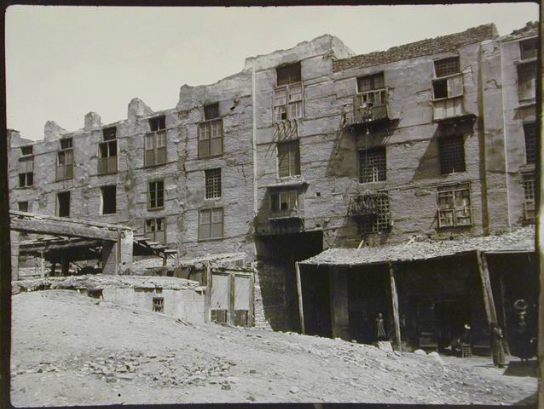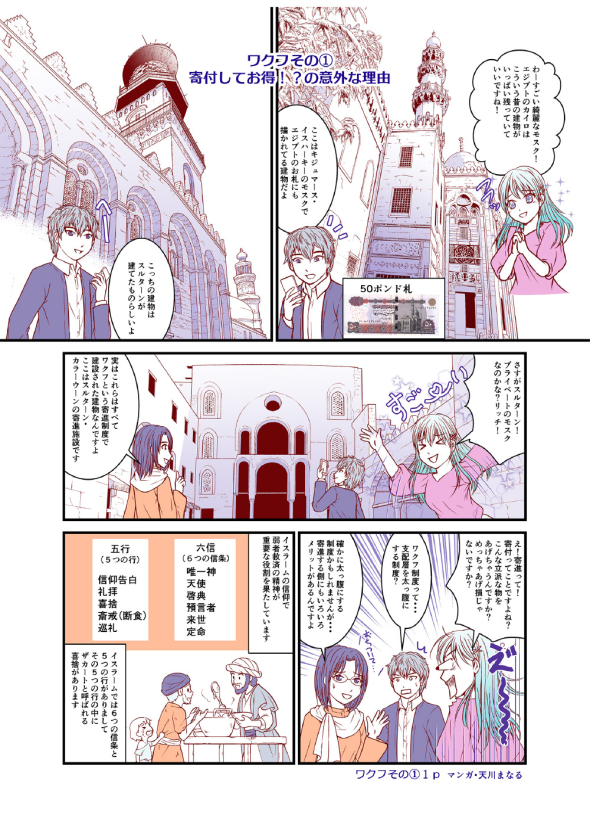The Religious and Socio-economic Significance of Waqf Charitable Endowments
This article discusses “waqf”, which refers to the practice in some Islamic dynasties of creating a charitable endowment as a legally established entity. (In North African regions, such as Morocco and Tunisia, this practice is denoted as “ḥabs”.) Waqf are said to have played major societal roles, such as establishing public works projects, as well as providing welfare and poverty relief before modern state-sponsored welfare and poverty relief programs existed.1
1 Çizakça, 2000; McChesney, 1991.
We will look at the various roles that waqf served for the local community and also for the individual donating the property, focusing on the Mamluk Sultanate period (1250–1517), which is when the Qalawun charitable endowment complex was built.
1.The Forms and Legal Definition of Waqf Endowments
The etymology of the term “waqf” traces back through Arabic words meaning a “stoppage” or “suspension”. Depending on the context, it can refer to the system by which property was donated, the management of the established Islamic trust, or the donated property itself. A term meaning “suspension” may seem like an odd choice for an endowment. In this case, it essentially means “stopping” or “ceasing” the private ownership and transfer of property by donating it through a permanent charitable trust. Since waqf trusts were intended to ensure the permanent stewardship of the donated property, they primarily consisted of residences and plots of land.22
2 The property established in waqf was basically operated through leases, which in principle had to be concluded and renewed each time the contract expired, up to a maximum of one year, or three years in the case of agricultural land. However, this principle was often violated due to practical problems, and the Mamluks had a practice of long-term leases known as hikr. In the Ottoman period, this principle was openly broken, and long-term lease contracts became one method of real estate investment. Baer, 1986; Cattan, 1955: 209; Hayashi, 2003: 189.
Still, they were not limited to real estate. For example, book collections were often donated. The front cover or colophon of the donated books would sometimes bear the inscription, “This book was donated by [insert name].” Incidentally, this type of inscription is often seen in mosques and madrasas, so look for it if you have a chance to visit one. A physician named Ibn al-Nafīs (died 1288), who had worked at the Qalawun hospital, donated his private book collection as a waqf, presumably intending the books be used to teach medicine at the hospital.3。
3 Munādama, 255.
There are multiple theories about the origin of waqf. There is one theory that the system originated in ancient Egypt. Another suggests ties to the charity practices of the Byzantine church. And another that it originates from the earliest days of Islam. In any case, it is probably safe to presume that, at a relatively early time, there existed some system that served as a model for waqf.4
4 Amīn, 2014 : 11-15.
Legal definition aside, variations in how waqfs were actually implemented and utilized in different times and places raises additional levels of complexity. To get a solid understanding, researchers diligently categorize waqfs from different perspectives, comparing them with funds and property held in conventional trusts,5 or viewing them as a form of asset retention.6 These studies, which attempt to clarify the functions and contexts of waqfs in particular periods and regions, tend to focus on “historical waqfs”. But waqfs are not mere relics of a bygone era. This is evidenced in the waqf-style approaches now being used to develop financial products, as support for Islamic Finance spreads.7
5 Çizakça, 2000; Cattan, 1955; Takaiwa, 2010.
6 Igarashi, 2011; Igarashi, 2015.
7 Kosugi, Nagaoka 2010; Nagaoka, 2011.
2.The Functions of Waqf Endowments
Having gotten a general idea of what waqfs are, now let’s look at how they actually work.
(1) Providing Urban Infrastructure Projects
First, there is the operation of religious and public facilities. Waqf endowments were used to operate the facilities that supported the day-to-day life of Muslims, such as places of worship (mosques), schools (madrassas), and even hospitals and equipment supplying water. Caravanserais (also known as khan, qaysariya, and wikala) and tenement houses (rab‘) were also built, which provided the income used to help operate these religious and public facilities, which were deemed “waqf beneficiaries”. Commercial and residential facilities were deemed “waqf properties”. Profits (including physical goods) acquired through the effective operation of waqf properties were transferred to the beneficiaries. These coordinated ties between waqf properties and their beneficiaries collectively shaped the day-to-day lives of Muslims. As these facilities were often built in densely populated urban areas, their waqf charitable endowments can be said to have benefitted the community’s infrastructure.

Photographed by K. A. C. Creswell (early 20th century)
Image: ARCHNET( https://archnet.org/media_contents/33611 )

© Qalawun VR Project (photograph by the author)
(2) Ensuring the Permanence of a Tomb Facility
For the donor, many of these religious and public facilities built through waqf endowments during the Mamluk period included a mausoleum. This indicates that the toilsome construction work provided private benefits as well as public ones. According to Islamic teaching, a tomb is considered temporary accommodation until Judgment Day. Since the mausoleum would presumably exist as long as the facility housing it continued to operate, the reason for including a mausoleum in one of these facilities was presumably to secure a place for the donor’s body to remain until Judgment Day.
Another merit to including a mausoleum in these religious and public facilities was making the mausoleum a place for charity. I will quote a hadith here:
When a man dies, his deeds come to an end, except for three things: ceaseless charity (sadaqah jariyah), a knowledge which is beneficial, and virtuous descendants who pray for the deceased.
Of these three things, the “ceaseless charity” refers to the charity work that continues after the donor dies, and the “virtuous descendants” refers to tomb visitors who pray to the donor for salvation. In other words, through ongoing charity work after they had died, the donors hoped to better ensure salvation in the afterlife. So, the mausoleums found in religious and public facilities are also tied to Muslim ideas about salvation.8
8 Sabra argues that in light of these points, the raison d’etre of the complex is the mausoleum; Sabra, 2000: 99.(http://www.muslim.or.jp/hadith/smuslim-top-s.html)
The Qalawun complex similarly included a mausoleum with a prominent dome where Qalawun, his son al-Nāṣir Muḥammad (reigned 1294–95, 1299–1309, 1309–40), and his grandson al-Ṣāliḥ Ismā‘īl (reigned 1342–45) were buried. The Qalawun mausoleum also served as a place for hadith studies and lectures on interpreting the Qur’an. Providing instruction in a mausoleum may seem odd, but there was a practical reason for this. Having the Qur’an and hadith recited daily beside the tomb where they “resided”, was an optimal arrangement for Muslims who wished for peace after death. In addition to waqfs that arranged for courses of instruction inside a mausoleum, there were other waqfs requiring Qur’an readings there.9
9 Kubo 2019: 6.
(3) Protecting and Passing on the Donor’s Property
Under the provisions of waqf-related Islamic law, as long as the donated property was (ultimately) used for charitable purposes, the donor was free to determine how it was used until then. Also, a living donor was not prohibited from serving as a trustee directly involved in the management of the property.10 These distinctively Islamic tradition regarding property donation differ from those of other religions and societies.
10 Although different schools of jurisprudence had different views on the involvement of the donor in operations, and it was often controversial even within the same school of jurisprudence. Contemporaneous historiography tells of many instances where the donor was involved in the trusteeship during his lifetime, indicating that it was not an uncommon practice. Peters, 2002: 63. Even in the Qalawun endowment, the endowment document stipulates that Qalawun himself would serve as trustee while still alive; Tadhkirat, 1: 369.
With these points in mind, donors often used waqf as a means of protecting their private property. During times of war and financial difficulty, Mamluk Sultanate officials would often confiscate privately held property. Putting one’s property into a waqf trust was seen as a way of avoiding potential confiscation. Property controlled by a waqf trust was to be used for the public good (maslaha), and had no rights of ownership. So, the act of confiscating public property would be in contempt of Islamic law, and would reveal the governmental officials as tyrants.
Also, donors would often use waqf as a way to pass property on to descendants without needing to divide it up. According to Islamic law, a person can leave no more than one-third of their property to a single individual. However, by taking advantage of waqf’s allowance for the donor to determine the use of the donated property, it was possible to prevent the property from being divided, and to transfer the usufruct of the property to a specified individual without violating the principles of Islamic law. In other words, de facto “inheritance” was made possible by including stipulations in the waqf trust that designated the descendants as beneficiaries, or that gave the descendants administrative rights after the donor died.
(4) Providing Poverty Relief and Charity Projects
How the waqf trust would operate was left to the discretion of the donor. So, the donor’s family typically retained some rights and powers, as long as the donor or his relatives were still alive. Most waqfs did, however, stipulate that once the donor’s family had died out, the proceeds from the endowment would be used for charitable causes and to help the poor.
Although most waqfs only described this with the wording “for the poor”, some waqfs stipulated specific purposes. Typical examples of the stated purposes of waqfs have historically included: distributing (as an act of voluntary charity, or sadaqah) bread and meat to the poor during important Islamic events such as the month of Ramadan, the Feast of the Sacrifice, and the evening before Friday prayers; sending Egyptian wheat to the holy cities of Mecca and Medina (collectively known as haramayn) where it was used to make bread and wheat porridge (dashīsha) that were distributed to the poor; and providing meals to impoverished travelers and students at the community meal-serving facilities (imaret) that developed during the Ottoman dynasty.11 The haramayn holy cities were the preferred choice for ultimate beneficiaries in many waqfs because of their connection to the Prophet.
11 Ito, 2011; Hasebe, 2004; Hayashi, 1989.
If the donor hadn’t designated a trustee, Islamic law required that the waqf be managed by a judge (qadi). If a trustee had been designated, a qadi would take charge of the waqf after the trustee died. So, even if the donor did not initially limit the waqf to serve for poverty relief and charity, it was nevertheless expected to ultimately be used for these purposes under the supervision of a qadi.
(5) Legitimizing the Ruling Class
Another important aspect of waqfs was that they served to legitimize the rule of the Mamluks that comprised the ruling class. The term “Mamluk” originally meant a “possessed person”, meaning a slave. But, historical sources from the era used the term to refer to Turkish and Circassian military slaves brought to Egypt from the Black Sea and Caspian Sea coasts. For such foreign-born slaves to maintain order while ruling over Egypt, Syria, and the Hejaz region, they had to show consideration for the Arab Muslims that comprised the great majority of their subjects. Waqfs were often established by Mamluks with that aim in mind.
For this article, due to space limitations, I have limited this overview of waqfs to cases from the Mamluk Sultanate, in which the Qalawun complex was built. However, as mentioned in Section 1 above, waqfs took on different forms in various regions and time periods. Research projects comparing them are still underway.12 These projects aim to determine how waqfs, often described with over-generalizations, actually functioned, influenced, and were influenced by the historical developments in varying region and period. The diversity of waqf’s socio-economic mechanisms can be taken as evidence that Islam was by no means a monolith. It had the flexibility and versatility to support the physical and spiritual lives of the people in each time and place. Being able to better understand the nature of Islam through the aspect of charity is one of the great pleasures of studying about waqf.
12 Here’s a list of recent seminars for international joint research related to waqf:
• From Practice to Norm – From Norm to Practice: Administrative Waqf and Other Foundations, France, July 2013.
• International Workshop on Waqf and its Terminology: Between Local Social Practices and Jurisprudential Norms, Algeria, June 2014.
• Comparative Study of the Waqf from the East: Dynamism of Norms and Practices in Religious and Familial Donations, Japan (Toyo Bunko), December 2015. (Discussion summary available as Miura, 2018)
• Workshop on Muslim Endowments in Asia: Waqf, Charity and Circulations, Singapore, October 2016
• Waqf Workshop, Qatar, December 2016.
• Stiftung in der Weltgeschichte, Germany, 2017. (Findings summary available as Borgolte, 2017)
• International Conference on the History and Governance of Awqaf in South and Southeast Asia: Colonial Interventions and Modern States, Malaysia, 2018.
• Cross-cultural and Comparative Study of Donation, Endowment and Benefit, Singapore, February 2020.
References
Primary Sources
Munādama: Badrān, ʿAbd al-Qādir. 1960. Munādamat al-aṭlāl wa-musāmarat al-khayāl. Damascus: al-Maktaba al-Islāmī.
Tadhkira: Ibn aḤbīb, Badr al-Dīn al-Ḥasan b. ‘Umar al-Ḥalabī. 1976-82. Tadhkirat al-nabīh fī ayyām al-Manṣūr wa banī-hi. 3 Vols. Cairo: al-Hay’a al-Miṣrīya al-‘Āmma.
Secondary Sources
Amīn, Muḥammad Muḥammad. 2014. al-Awqāf wa-al-hayāt al-ijtimāʿīyat fī Miṣr, 648-923 H / 1250-1517 M: dirāsa tārīkhīya wathāʾiqīya. Cairo, Dār al-Kutub wa-al-Wathā’iq al-Qawmīya.
Baer, Gabriel. 1986. “ḤIKR.” The Encyclopaedia of Islam, 2nd. ed., Leiden: E. J. Brill, 1960-2008, 3:368-370.
Borgolte, Michael (ed.). 2017. Enzyklopädie des Stiftungswesens in mittelalterlichen Gesellschaften. Vol. 3. Berlin: De Gruyter.
Cattan, Henry. 1955. “The Law of the Waqf.” in Khadduri, Majid and Liebesny, Herbert J. (eds.). Origin and Development of Islamic Law. Washington, D. C.: The Middle East Institute, 203-222.
Çizakça, Murat. 2000. A History of Philanthropic Foundations: The Islamic World from the Seventh Century to the Present. İstanbul: Boǧaziçi University Press.
Igarashi, Daisuke. 2015. Land Tenure, Fiscal Policy, and Imperial Power in Medieval Syro-Egypt. Chicago: Middle East Documentation Center.
McChesney, Robert Duncan. 1991. Waqf in Central Asia: Four Hundred Years in the History of a Muslim Shrine,1480-1889. Princeton & N. J.: Princeton University Press.
Miura, Toru (ed.). 2018. Comparative Study of the Waqf from the East: Dynamism of Norm and Practices in Religious and Familial Donations. Toyo Bunko.
Peters, Rudolph. 2002. “WAḲF.” The Encyclopaedia of Islam. 2nd. ed. Leiden: E. J. Brill, 1960-2008,11: 59-99.
Sabra, Adam. 2000. Poverty and Charity in Medieval Islam: Mamluk Egypt, 1250-1517. Cambridge: Cambridge University Press.
Secondary Sources in Japanese
Igarashi, Daisuke. 2011. Finances and Endowments of Medieval Islamic States: A Study of the Late Mamluk Dynasty (in Japanese), Tosui Shobo.
Ito, Takao. 2011. Waqf ad-dašīša of Mamluk Sultan Qāytbāy (in Japanese), Journal of Asian and African Studies 82, 31-60.
Kubo, Ryosuke. 2019. A Case Study of the Property and Waqf Endowments of Cairo Physicians in 15th‒Century Mamluk Society (in Japanese), History and Economics, 242, 1-17.
Kosugi, Yasushi and Nagaoka, Shinsuke. 2010. Islamic Banking: Finance and the International Economy (in Japanese), Yamakawa Publishing Co.
Nobuto Takaiwa. 2010. Waqfs and Trusts: A Comparison of “Property Arrangements” in Islam and The West (in Japanese), Journal of Islamic World Studies 3 (2), 241-254.
Nagaoka, Shinsuke. 2011. A Study on Islamic Finance in the Modern World (in Japanese), Nagoya University Press.
Hasebe, Fumihiko. 2004. “Saving the Poor in Medieval Egyptian Cities: The Madrasas of the Mamluk Sultanate” (in Japanese), in F. Hasebe (ed.) Saving the Poor in Medieval Mediterranean Cities, Keio University Press, 45-89.
Hayashi, Kayoko. 1989. The Life of an ‘Imaret’: a Charitable Institution in an Islamic City (in Japanese), Oriental Culture, 69, 119-144.
Hayashi, Kayoko. 2003. Islamic Law Reform: The Birth of a New Rental Agreement System in the Ottoman Empire (in Japanese), Islam and the Indian Ocean Rim, Iwanami Shoten, 169-191.
English translation by Jeff Gedert



